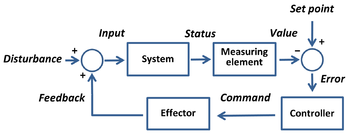Setpoint (control system)
This article is about setpoints in control theory. For other uses, see Set point.

Block diagram of a negative feedback system used to maintain a setpoint in the face of a disturbance using error-controlled regulation. Positive error means feedback is too small (controller calls for an increase), and negative error means feedback is too large (controller calls for a decrease).
In cybernetics and control theory, a setpoint (also set point, set-point) is the desired or target value for an essential variable of a system,[1] often used to describe a standard configuration or norm for the system.[2] Departure of a variable from its setpoint is one basis for error-controlled regulation,[3] that is, the use of feedback to return the system to its norm, as in homeostasis. For example, a boiler might have a temperature setpoint, which is the temperature the boiler control system aims to maintain.
See also
References
- ↑ An 'essential variable' is defined as "a variable that has to be kept within assigned limits to achieve a particular goal": Jan Achterbergh, Dirk Vriens (2010). "§2.3 Cybernetics: Effective methods for the control of complex systems". Organizations: Social Systems Conducting Experiment. Springer Science & Business Media. p. 47. ISBN 9783642143168.
- ↑ B. Wayne Bequette (2003). Process Control: Modeling, Design, and Simulation. Prentice Hall Professional. p. 5. ISBN 9780133536409.
- ↑ W. Ross Ashby (1957). "Chapter 12: The error-controlled regulator". Introduction to cybernetics (PDF). Chapman & Hall Ltd.; Internet (1999). pp. 219–243.
This article is issued from Wikipedia - version of the 10/13/2016. The text is available under the Creative Commons Attribution/Share Alike but additional terms may apply for the media files.